Retrospective: Heroes of Might & Magic III

Heroes of Might & Magic III after a year and a half is 20 years old. The game, which has conquered more than one generation with its magic, has not lost its appeal even today - many people call it “new chess”, claiming that nobody has been able to surpass the “magic” formula of the third “Heroes” since then.
Today, your attention is invited to the story of how HoMM III and its heirs were born. Considering that knowledge shedding light on the events of those days can always sink into oblivion, and even The Internet Archive (which has already happened with some interviews) will not save them - and the series itself, according to rumors, will Ubisoft be sent into a deep “freeze” due to the unimportant financial performance of the latter part of the franchise , it is better to do it today than tomorrow.
My story is a reconstruction of events that took place two decades ago, and it is based on dozens of sources - so it may contain some inaccuracies; Fortunately, the story has so far preserved enough information for us about how New World Computing and 3DO were able to produce a game that was so successful that we continue to play it years later. You learn about what happened after the release of the third "Heroes".
When it is over, you will forget about how hard it was for you, and you will want to repeat it again.
John Van Caneghem, "Worship for those who experience the crunch"
Disclaimer : every time when it comes to "Heroes", there is a person who immediately goes to install them. That is why there is simply no better day for publishing this post than Friday — so that everyone will have time to recover by Monday morning.
Man of Many Faces: JVC and New World Computing
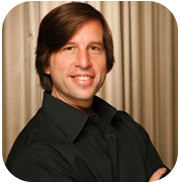 Anyway, the story of the “Heroes” necessarily has to start with John Van Canegem, his first company New World Computing and his main child (in the 80s and 90s) - a series of role-playing games Might & Magic , which is also "Might and Magic . "
Anyway, the story of the “Heroes” necessarily has to start with John Van Canegem, his first company New World Computing and his main child (in the 80s and 90s) - a series of role-playing games Might & Magic , which is also "Might and Magic . "')
Let the level of popularity of Sid Meier and Richard Garriot in the people of Van Kanegem never reached, among fans of RPG and turn-based strategies he has always been and remains a legend; fans of creativity still “affectionately” shorten his name to initials - JVC - just like his colleagues at New World Computing had once done a long time ago. So if you suddenly meet “JVC” on the course, don't be surprised - no, Japanese televisions have nothing to do with it, we are talking about the founding father of the “Might and Magic” universe.
In the early 80s, in the years of the gaming industry, almost everyone who decided to create and release his own game had a “garage” experience. Van Canegem also got this experience when in 1983 he founded New World Computing, whose office was located in his parents' house, and then spent three years developing Might & Magic I.
 At the stage of the formation of New World Computing (hereinafter referred to as NWC), JVC’s life was similar to what any indie developer knows today. When John worked on Might & Magic I: The Secret of the Inner Sanctum , he had to do almost everything - he had programming, game design, art, sound, texts and dialogues, sales, marketing, finance, and legal issues. Fortunately, the trial edition of the game, published by John at his own expense, was scattered instantly, and the publisher of Activision undertook to help with the spread of the game, which allowed Van Kanegem to switch to the creation of the next part of the series ...
At the stage of the formation of New World Computing (hereinafter referred to as NWC), JVC’s life was similar to what any indie developer knows today. When John worked on Might & Magic I: The Secret of the Inner Sanctum , he had to do almost everything - he had programming, game design, art, sound, texts and dialogues, sales, marketing, finance, and legal issues. Fortunately, the trial edition of the game, published by John at his own expense, was scattered instantly, and the publisher of Activision undertook to help with the spread of the game, which allowed Van Kanegem to switch to the creation of the next part of the series ...I will not talk here about the role-playing Might & Magic and its universe - it can pull on a separate post, and I suspect that there are a lot of similar posts written - but you should know at least one thing about it: a dizzying mixture of fantasy and science fiction -that tightened players. Role-playing series enjoyed tremendous success with the audience, and the total circulation of the M & M series games exceeded one million long before the second half of the 90s, and all this was done on their own by NWC.
Another thing is its strategic offshoot of Heroes of Might & Magic , which could never be born, but in the end it could outrun its once famous celebrity in popularity.
King's Bounty and Heroes appearance
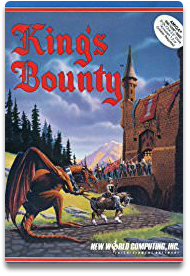 In fact, the main game design ideas of “Heroes” were already “run in” on another game of John - King's Bounty , which was born in 1990. Here we meet familiar elements of the gameplay of “Heroes” (although, it should be noted, similar ideas were in the air at that time, and in one form or another were also implemented by other developers): these are modes of map travel and tactical battles, a set of creatures, locking locks and the use of magic - only the player was given control by just one hero.
In fact, the main game design ideas of “Heroes” were already “run in” on another game of John - King's Bounty , which was born in 1990. Here we meet familiar elements of the gameplay of “Heroes” (although, it should be noted, similar ideas were in the air at that time, and in one form or another were also implemented by other developers): these are modes of map travel and tactical battles, a set of creatures, locking locks and the use of magic - only the player was given control by just one hero.King's Bounty was developed under DOS, later ported to a large number of other platforms, but apparently its sales compared with the flagship M & M series left much to be desired. In any case, no one in the company had any plans to continue King's Bounty, if not for one story.
As JVC has repeatedly told in almost every interview, the first “Heroes” were born thanks to his wife, who really liked King's Bounty. Here JVC and decided to make a sequel; however, the marketer's instinct suggested that if the name of the game was attributed to " Might & Magic ", then many would buy it without looking, so it was decided to link the game with the universe that had gained considerable popularity by that moment. There were no problems with the plot - after all, as the main plot of Heroes, from now on, there will be an additional story for the role-playing Might & Magic . The company will follow this scheme until its very last days.
Initially, Might & Magic was supposed to end on World of Xeen , but due to the growing popularity of the role-playing game and Heroes , it was necessary to quickly decide where the series should move on. Van Kanegem knew which way to go - but not in a hurry, because in 1993 it was not so easy to make a 3D MMORPG with a small, if successful, company.
The 3DO Company
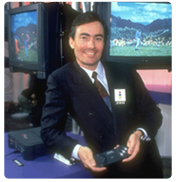 The 3DO Company was founded in 1991 by Trip Hawkins, a man who had previously become the founder of Electronic Arts. In the annals of the history of the gaming industry, he entered as a visionary who was able to transform the development of computer games from one-person projects into complex, complex projects that entire teams worked on.
The 3DO Company was founded in 1991 by Trip Hawkins, a man who had previously become the founder of Electronic Arts. In the annals of the history of the gaming industry, he entered as a visionary who was able to transform the development of computer games from one-person projects into complex, complex projects that entire teams worked on.I want to note that in those years it was not quite the same Electronic Arts that we all know so well today - the idea of selling additional content for games in EA will be discovered for the first time for us after Trip leaves the company, this method of monetization will be discussed by EA for the first time. around 1993 (if anything, we are talking about the prototype of the DLC - about microtransactions and lootboxes of speech then did not go). Electronic Arts of that time produced games of such remarkable companies as Bullfrog, which, under the leadership of Peter Molyneux, created Populous and Dungeon Keeper , which simply had no analogues.
Of course, this does not mean that Hawkins was not a businessman at heart, like most of the founders - but, at a minimum, Trip Hawkins knew a lot about the “right” games. After his initial plan for 3DO failed (I'm sure you have heard about the expensive 3DO prefix, to which there was no "normal" starting set of games, and which was finally finished off by the PlayStation), Trip in 1996 decided that 3DO should become a developer and publisher of games for PC, PlayStation and other consoles. From now on, all the company's efforts were focused on the development of brands - at the same time, each of the company's games was devoted to the development of only 6-9 months. If we forget about this tough restriction for a while, then otherwise for New World Computing, which at that time numbered about a hundred people, and Van Canegema personally began the most incredible adventure in their lives.
For 3DO, Might & Magic looked like a great asset and a bargain. JVC in 3DO attracted, most likely, something completely different: he finally could do what he had long dreamed of - MMORPG in the universe of “Might and Magic”. His interest was justified - after all, the first commercial 3D MMORPG, called Meridian 59, belonged to the 3DO publishing pen.
However, work on this project was delayed, and in order to stay afloat, it was decided to continue the old scheme: first, HoMM II was required to finish (the rights to its 3DO edition bought for $ 13 million), and also to make and issue the next number parts of M & M and HoMM , which even today is considered by many to be the best in the history of both series - Might & Magic VI: The Mandate of Heaven and Heroes of Might and Magic III: The Restoration of Erathia .
All this would not have happened if in 1996 the NWC had not bought the publisher 3DO. As the press release read, this decision allowed Van Kanegem to "focus on creative tasks instead of managing the company." Of course, most M & M fans didn’t even suspect what was hiding under these words.
Ironically, the game Might and Magic Online will never see the light, and in the long run, the decision to trust in 3DO will be a mistake ... However, we'll talk more about that.
Here our introduction ends (it is quite possible that you already knew about all this), so we are finally moving on to the most interesting part - how Heroes of Might & Magic III was directly developed.
Team gathering and pre-production
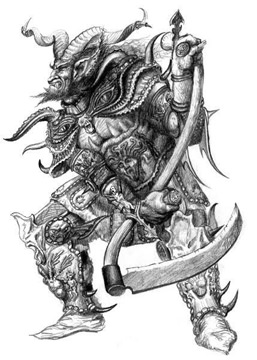 In NWC, it was considered commonplace to transfer programmers from one project to another after the previous one was completed, so immediately after completing work on HoMM II, some of its developers went to do a new role-playing M & M. Their place was to be taken by “fresh blood”, and in fact the new employees were faced with a very ambitious task.
In NWC, it was considered commonplace to transfer programmers from one project to another after the previous one was completed, so immediately after completing work on HoMM II, some of its developers went to do a new role-playing M & M. Their place was to be taken by “fresh blood”, and in fact the new employees were faced with a very ambitious task.Judge for yourself: at that time, HoMM II just ranked sixth in the list of the best games of all time according to PC Gamer magazine, and the players' expectations from the continuation were incredibly high. In which direction did the NWC have to move in order to once again surpass themselves?
To answer this question, Van Kanegem and Hawkins began a search for new personnel. The first candidate was David Mallich (Mullich) ( Davic Mullich ), known at the time of participation in the creation of the Disney DuckTales , as well as the now cult I Have No Mouth, And I Must Scream . In truth, he and Van Canegem had known each other for several years - after all, they had performed at the GDC together - so it’s not surprising that Mallich was glad to have the opportunity to work together.
So, David Mallich was appointed project manager. When management asked David what to change in Heroes, he directly expressed his opinion: the artistic style of the game was hopelessly outdated and five years behind the life - it was urgent to change something. Hawkins and Kanegem were satisfied with this answer. On his first working day, Mallich received from his manager the following task: to identify a new art director for the project, which the “Heroes” development team really wanted.
Surprisingly, the lead game designer of the upcoming “Heroes”, Gregory Fulton, got a job at the NWC on the same day as Mallichch. When they met, they discussed for a long time how the series could move in relation to art. In the end, they agreed on the need to look towards the Warhammer universe. David Mallich decides to call this style the term " extreme fantasy ". (In the future, Fulton will keep a development diary for Heroes , who will document some funny sketches from the studio's life in the last three months before the release)
After that, Mallich talked to each of the artists who worked in the company, and as a result, he chose Philan Sykes, a talented artist who was the only one who was unhappy with the style of the second “Heroes”. She was appointed to the position of art director, and from that moment on “Heroes” left the “fairy-tale” graphics and headed for a much more realistic depiction of fantasy creatures. Funny fact: it will be remembered to her colleagues by the fact that she will diligently avoid using orange in the design of the game.
The only programmer George Ruof ( George Ruof ) inherited from the second "Heroes" was inherited from the second "Heroes" - all the others left to do the role-playing Might & Magic (which will happen more than once or twice). Using his contacts, David called to the project two former fellow programmers who helped him with the work on I Have No Mouth, And I Must Scream .
The entire development team of Heroes of Might and Magic III (according to David Mullich) consisted of 30 employees. Twice a year, Trip Hawkins visited them on a business trip and talked about what was awaiting the company in the future (usually NWC employees met these visits with unprecedented enthusiasm, as they enjoyed a little respite from work). The atmosphere in the team was wonderful (especially at first) - any employee could make a significant contribution to the creation of the game, because colleagues and bosses listened to each of them.
So, when the core of the team of new “Heroes” was formed, it was possible to begin the direct production of the game.
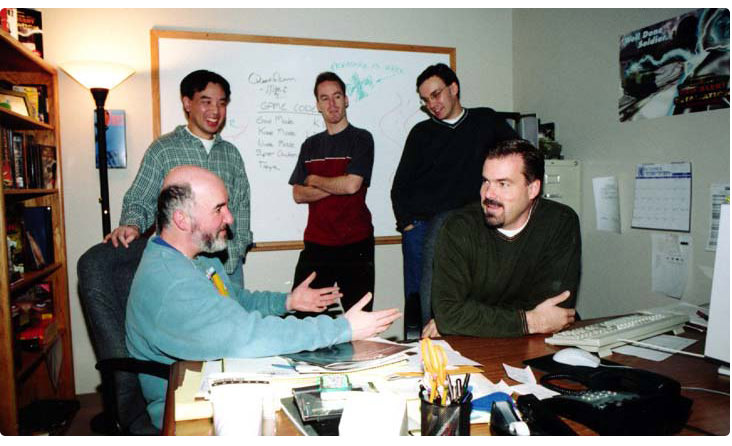
Development
Many of us are familiar with the obsessive desire to “redo everything from scratch,” but 3DO and Van Kanergem were strongly opposed to this approach. They did not disappoint this time either, by inviting the “Heroes” team to be guided by the slogan “not a revolution, but an evolution” . In other words, it was necessary to rely on a limited budget and a short development time, and the leadership offered to focus on game design, balance, artwork and the overall level of polishing of the game. Not a bad option, it should be noted!
Full-scale work on the game began in the winter of 1997/1998. One of the new programmers, David Richie (David Richey), began his work with the fact that he completely remade the map editor. This allowed game designers and level designers (of whom there were six) to disperse completely and not restrain their imagination. Despite the fact that the game engine remained the same, there were a lot of new features and content in the game, starting with updating the magic system and ending with the number of places on the adventure map that could be visited.
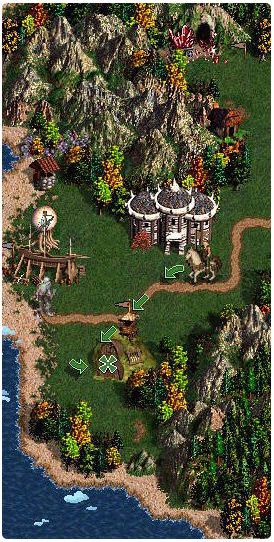 Innovation is still present. Heroes of Might & Magic III was the first game in the series in which pre-rendered 3D models came to replace hand-drawn sprites and pixel-art. Marketers have dubbed the new “Heroes” style as “ bright and polite ”, whatever that phrase may mean. Philan Sykes and his assistants will not let you down: during the development of the game, the artists of the company will draw about 10,000 different concepts.
Innovation is still present. Heroes of Might & Magic III was the first game in the series in which pre-rendered 3D models came to replace hand-drawn sprites and pixel-art. Marketers have dubbed the new “Heroes” style as “ bright and polite ”, whatever that phrase may mean. Philan Sykes and his assistants will not let you down: during the development of the game, the artists of the company will draw about 10,000 different concepts.Some time after the start of the project, several more developers will come to the company and they will be engaged in AI programming ( Gus Smedstad ) and multiplayer ( Jeff Leggett ).
The music of the series will traditionally remain at the highest level; Rob King and Paul Romero will again deal with it.
Van Canegem personally kept abreast of the development and took an active part in it. Employees often received advice from him and listened to criticism when something went wrong. While working on the balance of the game, Greg Fulton first modeled the parameters of creatures and heroes in Excel, and then discussed and tested them with Van Canegem.
The creation of maps for the game took so much effort that the level designers even invented their own term - “ thousand tile stare ”, by which they meant the tired look of a person who spent the whole day creating and editing game levels for “Heroes”.
The traditional "crunch" lasted from developers for the last 5.5 months before the release - from September to February. Attributes of the crunch were not less traditional: working days were delayed until 10-18 hours, someone constantly worked on Saturdays and Sundays, within the framework of the action “ working for food ”, they ordered Mexican, Chinese food and pizza to the office. The process of working on the game has also undergone a noticeable change: now that work on all the fundamental things was behind (the design document was completed), everyone switched to helping each other - there were still a lot of tasks.
When all the cards were completed 2.5 months before the release, all NWC employees, starting with Van Canegem, would have to play and polish the game. A few days after the start of testing, a bug was found that allowed AI to “cheat” - artificial intelligence managed to hire more creatures than it was actually available for hire at the moment. And besides, the AI still behaved ugly for the time being - stayed until it gathered such an army that the player had no chance. Either you waited for an AI player to play the whole game and never saw it, or he suddenly appeared in front of the walls of your city in full military armament, and you didn’t even have a single chance.
The further, the more the accumulated stress affected the NWC employees. Programmers swore with managers and game designers because of unrealistic deadlines for developing features and too lengthy problem statements. One day, shortly before the release of the game, one of the testers managed to accidentally “set on fire” a Coca-Cola machine gun when trying to pull a bottle out of it and inadvertently damaged the wires. Fortunately, no one was hurt, but the case was remembered by all the staff.
I have to admit that in the lighted Coca-Cola vending machine I see the metaphor of the development process of Heroes III. A fire begins, someone panics, and someone else calmly comes and solves the problem. By golly, this is exactly what the process of creating computer games looks like.
Greg Fulton
A couple of weeks after the start of the internal playtest, a working multiplayer appeared in the game, and there was again an addition to the bug regiment. Among other tasks was a weighty 144-page manual and work on the International Translation Kit for localizing games to other languages.
The game went gold on February 16, 1999 - on that very day the “master CD” was ready. The day before, Kranch reached the pinnacle of his madness: the team was faced with the fact that no one would go home until the final version of the 3DO game was delivered, and they were obliged to continue working on the game until it stops. Needless to say, the next day, by the morning, half the team was still in the office ...
Work on the game was over. Not believing their joy, many "cut down" from the overvoltage, which they experienced in recent weeks. This did not prevent the team from just four days later discussing the first game supplement. It was necessary to carry out a 3DO plan, according to which a new game / addition in the “Heroes” series was to be published once a year.
February 28, 1999 was the actual release. I do not know how Frederick Brooks would be pleased with HoMM III, if he viewed the game as a software project; one thing remains: the development of the game took exactly as long as it was planned - 14 months. The team has successfully survived the development of the full. Most of the bugs and shortcomings found later will still be corrected later, already in numerous additions to the game - but on the release, the pure “Heroes” held up quite well.
The players were delighted - or rather, they had no time to express their opinions - they were busy playing. The critics were delighted - as one game publication jokedly wrote, “we had to handcuff the reviewer to the pipe, otherwise the patient refused to write a review of the game and continued to reach for the keyboard with the mouse” . Heroes of Might & Magic III and in our time regularly falls into all sorts of tops of the best strategic games of the last 50 years.
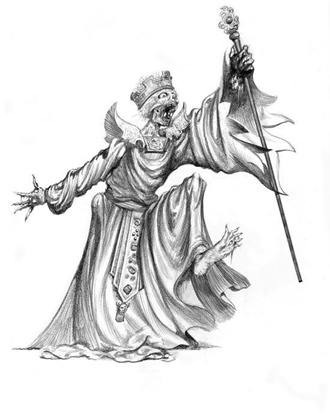
Life, striped like a zebra
Everyone who was at least a little interested in the history of Might & Magic knows: there are almost more canceled games in this universe than the ones released. I just didn’t spend money on 3DO trying to earn more!
Therefore, despite the fact that Heroes III was a phenomenal success and brought 3DO the most “ mountains of gold ”, the company continued to experience serious financial difficulties. Of course, 3DO already had a “brilliant” idea at the ready: to create another spinoff series, Legends of Might and Magic .
On paper, the project looked just incredible: it was a mixture of Neverwinter Nights and MM9 . Van Canegem was actively involved in the project, and did not have the opportunity to work on Heroes IV , except for the lengthy wishes of the team, and the decisive word about the vision and game design of the new part of “Heroes”. But for him it was worth it, according to rumors for his time the project was planned really advanced. Take a look at this Legends of Might and Magic trailer, first shown at E3 2000.
As a result, having worked on the design of the game and prototypes for 2 years, and at the same time approaching the release poorly, the team decided: the game should be cut mercilessly, and this should be done urgently. The resulting team shooter, which no one called a fantasy Counter-Strike, appeared on the shelves in mid-2001 and did not gain popularity either among the press or among the players.
As a result, the game failed miserably, making the gaping hole in 3DO finance even bigger. There is only one advantage in its release: JVC could finally return to full-fledged work on “Heroes”, but it was too late ...
I think this small digression gave you a rough idea of the state of both companies during the development of the fourth “Heroes”. All this has a direct effect on how they turned out.
Somewhere in the background of everything that is happening, Trip Hawkins began vainly flooding the blazing fire of the crisis , spending his personal savings to keep 3DO afloat, which allowed NWC to finish the MM9 and the fourth Heroes.
Heroes of Might and Magic IV: Tragedy
Oddly enough, the first blow to the fate of the fourth "Heroes" came from the "Heroes" of the third and the gaming community.
As you know, Heroes have always kept aloof from the science-fiction "twists" of the role-playing series, while remaining pure fantasy. When, as an idea for the second addition to HoMM III, chief designer Greg Fulton proposed to implement the sci-fi city Forge (Forge), in which goblins will live with blasters and minotaurs with jet-packs. When this idea was made public (along with the renderers of the finished city and concept art), the players took it into hostility. 3DO has received more than a hundred letters containing polite requests to refrain from such a decision; The forums were also full of dissatisfied.
And not only did Fulton have to take his words back and apologize to the offended innovations by the fans; Soon 3DO announced that in one of the letters, one of the players threatened to kill Greg. When Fulton found out about this, he quit his job - and the upcoming Heroes IV lost their main designer.
When it was time for NWC to move on and start working on the fourth part of the franchise, David Mallich was forced to choose a new game designer. It was Gus Smedstad, who was involved in AI programming for HoMM II . Considering that Van Kanegem was busy on other projects, this was a logical decision - according to rumors, only JVC knew better than Gus the game. However, due to the financial constraints of 3DO and the inability to hire new people, Gus had to fulfill two roles at once - the lead developer and the lead designer. All Mullich's hopes to hire 5 more programmers did not materialize (he would get this opportunity only 6 months before the game’s release, when it would be too late) - while all those who were involved in programming HoMM III were swallowed by Legends of M & M.In addition to Gus, only one more programmer worked on the project for a long time, and he was additionally loaded with the development of six mini-add-ons for past Heroes.
Even such an "anemic" team still had chances for success if it were not for Van Kanegem. He gave the team a few ideas - in particular, suggested how to rethink each of the game elements - and, after giving the green light to the design, he went to work on the Legends of Might and Magic . When he finally returns to the “Heroes” after many months, breaking away from the loser shooter and regular arrivals in racing cars, it will be too late - even the nights spent discussing and correcting deficiencies will not save.
The leaders of the fourth “Heroes” themselves argue that the main problem was “communication breakdown” between level designers and game designers - they could not find mutual understanding on several issues, in particular, at levels a clear inclination towards text quests and adventures was traced - while strategic Not enough attention has been paid to the side of the game.
If you were in the place of 3DO at that time, you probably would have suggested another idea: the series should take a step in 3D. Could 3DO and New World Computing cope with this new challenge? A similar act taken at the time in the Maxis studio against another large studio almost killed the company itself.
Maxis, SimCity , The Sims Spore ; , 20 ( , — ) — . Maxis , SimCity , , EA .
— - EA , ? , ; EA, SimCity 3D, The Sims .
, The Sims EA, , , « ». , — Spore . , , SimCity (2013) — Electronic Arts.
 Returning to New World Computing, we ask ourselves a simple question: was the transition to 3D discussed within the company? Of course it was discussed! Even more: on the agenda was the question of completely rewriting the game from scratch, because the programmers were unhappy with what the source code of the game turned into, from which King's Bounty’s ears still protruded . Here are just Van Kanegem put a "veto" on this proposal, deciding that the time for the transition of the series in 3D "has not yet come." Therefore, the pre-rendered 3D graphics and the good old engine, which faithfully served the series for a dozen years, went into action again ...
Returning to New World Computing, we ask ourselves a simple question: was the transition to 3D discussed within the company? Of course it was discussed! Even more: on the agenda was the question of completely rewriting the game from scratch, because the programmers were unhappy with what the source code of the game turned into, from which King's Bounty’s ears still protruded . Here are just Van Kanegem put a "veto" on this proposal, deciding that the time for the transition of the series in 3D "has not yet come." Therefore, the pre-rendered 3D graphics and the good old engine, which faithfully served the series for a dozen years, went into action again ...In reality, by the time HoMM IV is released, everything that is possible will be three-dimensional. Another question is that in order to move the game to the third dimension, it was necessary not only to prepare fans of the series for this, but also to solve the problems of game design that the series would have faced when switching to the third dimension. And because of noticeable financial difficulties, 3DO could not afford such a luxury.
What ultimately went wrong? The overwhelming majority of players (and game designers) in those years agreed that the developers decided on too much innovation, which ultimately ruined the game.
But the worst was that the fourth “Heroes” once and for all divided the fans of the series: while the transition from the second to the third heroes was quite a “planned” one and allowed to keep most of the fans, the fourth part liked one and shock for others. The friendly game base "Heroes" in the most natural way split into two warring camps. After such an ambiguous release, the future of fantasy TBS no longer seemed so bright to the players ...
I know that I can hardly believe this, but unlike the NWC, 3DO did not at all consider Heroes of Might & Magic IV a failure. In the wake of the success of the third part, the fourth “moved out” to a normal level of sales. John Van Canegem was clearly unhappy and threatened to personally lead the development of the fifth part of Heroes; Trip Hawkins was happy - after all, the game no longer needed to spend money, on the contrary, it brought them - even if not as much as it could bring, give 3DO developers some more time.
If you wish, you can understand both of them.
 The 2003 “Proevies” borrowed $ 3 million from the Trip Hawkins pocket, in addition to the $ 15 million dollars borrowed from GE Capital, 3DO again left without means of subsistence - and that's when 3DO needs another loan, Hawkins decides it’s time stay. More 3DO will not receive any money, and will be forced to file for bankruptcy in 2003; after her go to the next world and the NWC .
The 2003 “Proevies” borrowed $ 3 million from the Trip Hawkins pocket, in addition to the $ 15 million dollars borrowed from GE Capital, 3DO again left without means of subsistence - and that's when 3DO needs another loan, Hawkins decides it’s time stay. More 3DO will not receive any money, and will be forced to file for bankruptcy in 2003; after her go to the next world and the NWC .The most interesting thing is that both Heroes IV and New World Computing could be saved if it were not for the greed of the 3DO guide.
Ubisoft has long been eyeing the creative heritage of NWC, and for the first time, Ubisoft representatives turned to 3DO with a proposal to sell the Might & Magic franchise during the developmentHeroes of Might & Magic IV and MM 9 . However, Trip Hawkins decided to refuse the French company, hoping that they would soon return with a better offer. His expectations were not met, and only a year later, 3DO became bankrupt, putting all its games under the hammer.
The rights to the Might & Magic series Ubisoft will eventually buy for $ 1.3 million.
Heroes of Might & Magic V, which were not
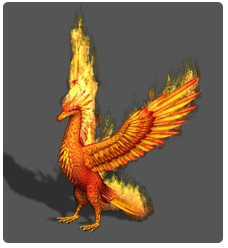 Although not for long, Heroes V as amended by the NWC did exist. This is a documentary fact that was confirmed by various leaks and eyewitness accounts. The latter claimed that the design of the game was in full swing, and the list of factions was already ready, as well as the plot synopsis.
Although not for long, Heroes V as amended by the NWC did exist. This is a documentary fact that was confirmed by various leaks and eyewitness accounts. The latter claimed that the design of the game was in full swing, and the list of factions was already ready, as well as the plot synopsis.The company understood that they didn’t have much time and resources left and, in terms of art, didn’t change anything, making a bet on the pre-rendered 3D graphics in the spirit of HoMM IV. Van Canegem fulfilled his promise and made several changes that the fourth “Heroes” lacked: it was necessary to get away from the “quest” narrative style in the direction of strategic gameplay, “cut” role elements, substantially reduce the bestiary, and rewrite AI from scratch. Three of the six cities were already ready in draft when the work on the game had to stop.
But, as we already know, these “Heroes” were no longer destined to see the light. All that has come down to us is concept art and pre-renderers kindly laid out by ex-NWC artists.
"Real" HoMM Vwill rise from the ashes five years later through the efforts of Nival Interactive. Ubisoft itself will call them "restart". John Van Kanegem refuses to take any part in their creation, and at the request of the French publisher Steve Fokner ( Steve Fawkner ), an experienced game designer and creator of another popular TBS - Warlords, will take his place .
If you want to know how Nival was able to cope with the difficult task of translating "Heroes" into 3D, then I strongly recommend you to read the post of former game designer Nival Alexander Mishulin "The Way of Heroes: Designer Post-mortem" , which contains many interesting things and sheds light on the completely unobvious things that Niva had to deal with while working on the game.
, , , … . , , , .
, « : »

The build of the stolen FPP version of Heroes of Might & Magic V , intended for the publisher, could be bought on the disk in the stalls long before the release of the game itself, similar to STALKER and Half-Life 2 and DOOM 3. This build was known among the players as “alpha” .
Today Sergey Orlovsky calls “Heroes” the most important project in the life of Nival. Van Canegem calls the fifth part “amusing”, while noticing that he really liked the modern remakes of King's Bounty . Well, to each his own, and it's almost time for us to disperse, but first a little surprise awaits you.
Heroes of Might & Magic VI, which were not
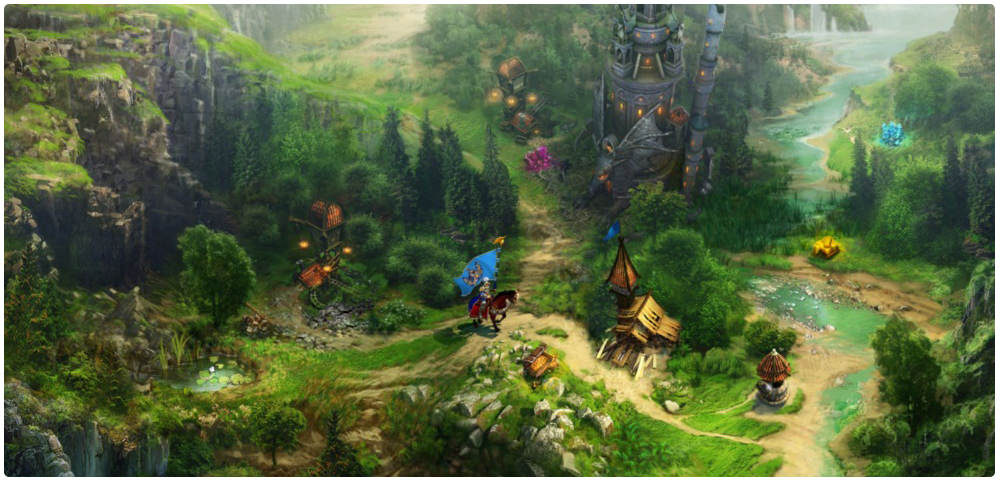
In fact, there is another project that still does not give rest to your humble servant. This is a semi-mythical HoMM VI , which Nival did for Ubisoft, but something went wrong , and the development was given to another studio, Black Hole Entertainment.
According to one theory, this version was used by Ubisoft at the pre-production stage of the game. Officials hinted that the development of the sixth part of the game began in 2006, and Nival was involved in the process until the creation of a playable demo. Starting from the sixth part, one of the publisher’s requirements was to get rid of the “city screen” so beloved by the players - which, as we know, would really happen in the seventh part of the series - and the mocap meaningfully hints that most of the action should now happen in adventures.
Presumably, this concept game includes the following concept art.and a few mockups, one of which you see above. I haven’t seen any real screenshots from this legendary version, so I’ll not confidently say that it existed. The reasons for which Ubisoft decided to change the developer after such a strong “reboot” as HoMM V , a more or less warmly received fan, I also do not think; it is hard to believe that Nival did not try to make a pitch of the sixth part of “Heroes”.
Let's hope that one day someone will shed light on this story.
P.S
What happened to the "Heroes" further - you probably know as well as I do. After the release of quite successful HoMM V and Dark Messiah of Might & Magic in 2006, Ubisoft will try to fully restart the brand, releasing the interconnected Might & Magic X: Legacy and Might & Magic Heroes VI .
Considering that Ubisoft never had big commercial expectations from the franchise, Heroes was still lucky - the strategic game series was cheaper to produce by definition, so the light could see its sixth and seventh parts.
Hungarian studio Black Hole Entertainment, founded by Andrew J. Vaina, a Hollywood producer and part-owner of a casino in Las Vegas, has not been famous for “strong” projects before (if you still remember a game like Warhammer: Mark of Chaos - means , with marketing, they just had everything in order); HoMM VI became a “swan song” for her - after the release of this game, the company went bankrupt, but finally shared its experience with Ubisoft .
Black Hole used all its reserves for 6 months just to complete the project ... it cost us more than 1 million euros. There was no chance to return what was spent, because under the contract of royalties we would receive no earlier than the moment when 2 million copies of Heroes VI will be sold on full-price.
<...>
For the last 10 months we have been working literally 24/7 without any hope of compensation ... because of this, we could not survive the release of the game and find another project.
<...>
Heroes 6 was a giant project, 1.5-2 million lines of source code. This is more than most RPG. Such a project can really be completed in just a few years and on a budget comparable to what Blizzard has. 9 months after the start of our work, UBI kept sending new ideas and change their decisions, and so on until the release itself.
My experience of communicating with developers from Hungarian and Romanian studios tells me that there is no reason not to trust him - all the problems described could well have occurred. In general, after reading the emotional letter from an anonymous studio employee, we can only guess how, with this publisher, Nival managed to make such a cool fifth part - however, it is not surprising, because the same letter suggests to us that about Nival in Ubisoft were not the best opinion.
They say that the developers of Might & Magic X: Legacy , Limbic Entertaiment, jokingly called it Might and Magic: Legend of Grimrock - the thing is that, according to sources, the money for the development of M & M: X Ubisoft decided to issue only on the wave of financial success of another game - Legend of Grimrock . Probably, their working conditions were no better, since the creators of M & M X and HoMM VII no longer have any relation to the franchise and are now busy developing a new Tropico .
And is it worth continuing? .. After the release of Heroes of Might & Magic VII, many reviewers voiced what had long been hanging in the air - it looks like Ubisoft was completely confused between trying to please the fans, leaving everything “as it is”, and trying bring any innovations to the series ...
 ... Meanwhile, the adventures of John Van Canegem continued, but in the new setting of the “Investments and Startups” universe. Track it further path is not difficult. After several years of working at NCSoft on an unannounced project, he, along with one of the former vice-presidents of EA, becomes the founder of Trion Worlds. Trion Worlds will create MMO Heroes of Telara , which will be released only in 2011 under the name Rift (the total cost of the development will be more than 50 million dollars).
... Meanwhile, the adventures of John Van Canegem continued, but in the new setting of the “Investments and Startups” universe. Track it further path is not difficult. After several years of working at NCSoft on an unannounced project, he, along with one of the former vice-presidents of EA, becomes the founder of Trion Worlds. Trion Worlds will create MMO Heroes of Telara , which will be released only in 2011 under the name Rift (the total cost of the development will be more than 50 million dollars).But John will leave the company long before this point by going to EA, where he will again work on strategy - Command & Conquer: Generals 2 . Alas, the project, which the management regularly threw from side to side (from the premium strategy with the main focus on multiplayer to the free-to-play model), did not justify the hopes that pinned him in the walls of EA. After large-scale alpha testing, which was delayed for several months, the project will be canceled in October 2013 due to "inconsistencies with the players' expectations".
As a result, in 2014, John will leave the walls of EA and follow the example of his colleagues, with whom he once started his own business: after attracting $ 5 million investment, he founds the company VC Mobile Entertainment, which will develop the mobile game Creature Quest. Today over 20 people work on the game, and Van Canegem is actively engaged in its promotion. The decision to switch to mobile games JVC justifies the desire to "be on the platform that allows today to cover the majority of players." Today, John is still being asked about “Heroes” in almost every interview, but it does not look like he showed a really burning interest in Heroes - although he used to be very sorry that he didn’t decide to buy the rights to Might & Magic .
Former head of the development of the third and fourth “Heroes” David Mallich will contribute to the creation of another legendary RPG, which has not yet received a worthy heir - this is Vampire: The Masquerade - Bloodlines . Today, he is engaged in counseling, teaching disciplines related to games in educational institutions, and also complains of age discrimination in the western gaming industry due to the massive refusals of large companies to hire him. He continues to keep in touch with most of those who worked on the third “Heroes”.
The rest of the former NWC employees still do their best for Trip Hawkins and speak warmly about the period of their life when they could come to work and engage in creative work along with the rest, participating in the creation of incredible games that the whole world was waiting for with bated breath.
As the design of the article used concept art created by the artist George Almond for Heroes of Might & Magic III. For the first time, these images were published by Ubisoft in celebration of the 15th anniversary of the game.
Have a good Friday and have a nice weekend!
Source: https://habr.com/ru/post/342734/
All Articles
